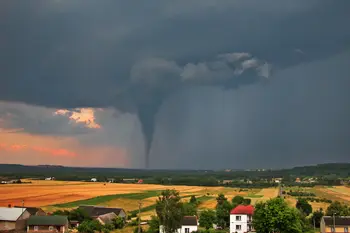Tornadoes strike with little warning and can cause catastrophic damage in seconds. According to the National Weather Service, these powerful storms touched down 1,882 times across the United States in 2024 alone, a near-record number. And while some regions face a higher risk than others, tornadoes can happen anywhere.
However, knowing what to do before, during, and after a tornado can help protect your family and home from devastation. Let’s go through seven safety tips so you’ll know how to prepare for a tornado whenever disaster strikes.
What to Do Before a Tornado Strikes
The best time to get ready for a tornado is before you see it in the forecast. Follow these tornado safety precautions to stay safe when the warning sirens sound.
1. Know Your Risk and Have a Plan
The first step in tornado safety is understanding your local risk. Tornadoes can happen in almost every U.S. state, but areas known as “Tornado Alley,” which includes Texas, Oklahoma, Kansas, and Nebraska, are at higher risk.
Once you know your risk level, create a family emergency plan that includes:
- A designated shelter location: Choose a basement, storm cellar, or an interior room on the lowest floor with no windows.
- Family communication strategy: Make sure everyone knows how to reach each other if separated, and designate an out-of-area contact.
- Evacuation routes: Identify multiple ways out of your home and neighborhood.
- Pet accommodations: Plan where your pets will go during a tornado, and keep their supplies ready.
Practice your plan at least twice a year so everyone knows exactly what to do when the time comes.
2. Prepare an Emergency Kit
A well-stocked emergency kit can save precious time when a storm is approaching. Keep essentials in a durable, easy-to-carry container in your designated safe room. Include:
- Water and nonperishable food (enough for at least 72 hours)
- Flashlights and extra batteries
- First aid supplies
- A battery-powered or hand-crank radio
- Copies of important documents like homeowners insurance policies and IDs
- Prescription medications and pet supplies
Check your kit every few months and replace expired items. You can also use this helpful checklist to make sure you have everything covered.
3. Protect Your Home in Advance
Preparing your home before tornado season can reduce damage and keep your family safer. Here’s what you can do:
- Reinforce doors and windows: Install storm shutters or use plywood to board up windows when a tornado is predicted.
- Secure outdoor items: Bring in or anchor down furniture, potted plants, trash cans, and other items that could become projectiles in high winds.
- Trim trees and shrubs: Remove diseased or damaged branches that could fall on your home during a storm.
- Consider home upgrades: If you live in a high-risk area, upgrading to reinforced garage doors or storm shutters can provide extra protection.
How to Stay Safe During a Tornado
When a tornado warning is issued, every second counts. Here’s what to do to keep yourself and your loved ones safe.
4. Take Shelter Immediately
As soon as you hear a tornado warning, move to your designated shelter spot. Don’t wait to see if the tornado is coming your way because tornadoes can change direction quickly.
“If you can’t get underground, get small and cover up,” says Steve Bennett, Sr. Director, Climate Science and CAT for Mercury Insurance. “The goal is to put as many walls between you and the tornado as possible.”
Follow these guidelines:
- Go to the lowest floor: Basements and storm cellars offer the best protection.
- Choose an interior room: If you don’t have a basement, move to a small, windowless room like a bathroom, closet, or hallway on the ground floor.
- Avoid mobile homes and cars: These offer little protection. If you’re in a mobile home, leave immediately and find a sturdy building or designated storm shelter.
- Stay away from windows: Flying debris can shatter glass and cause serious injuries.
If you’re caught outside with no shelter available, lie flat in a low-lying area like a ditch and use your arms to protect your head and neck. Also, watch for flash floods, which can sometimes accompany tornadoes.
5. Protect Yourself from Flying Debris
Most tornado-related injuries occur from debris, not from the storm’s winds themselves. Once you’re in your shelter, take these extra precautions:
- Use helmets, heavy blankets, or mattresses to shield your head and neck.
- Keep pets and family members close in your safe space.
- Stay put until you’re sure the storm has passed and it’s safe to move.
What to Do After a Tornado Passes
Once the storm is over, the danger isn’t necessarily gone. Follow these steps to stay safe during recovery.
6. Stay Alert for Ongoing Dangers
After a tornado, your home and neighborhood may have hidden hazards. Here’s what to watch for:
- Downed power lines: Never touch or go near them, even if they appear inactive. Stay at least 30 feet away and report them to authorities immediately.
- Gas leaks: If you smell gas or hear a hissing sound, leave the area and call your utility company or 911.
- Flooding: Heavy rain and damaged infrastructure can cause flash flooding. Avoid walking or driving through standing water.
- Structural damage: Check your home for cracks in walls, foundation damage, or sagging ceilings before reentering.
Additionally, stay informed by listening to local updates on your battery-powered radio or phone for information on road closures, boil water advisories, and other safety alerts.
7. Contact Your Insurance Agent Quickly
If your home sustained damage, acting fast can help speed up repairs and your insurance claim. Here’s what to do:
- Document the damage: Take photos and videos of all affected areas before cleaning up or making temporary repairs.
- File a claim immediately: Contact your insurance provider as soon as possible. Have your policy number ready and be prepared to provide details about the damage.
- Keep receipts: Save records of any emergency repairs, temporary housing costs, or other expenses related to the storm.
- Work with your adjuster: Keep copies of all communications with your insurance adjuster and provide them with the documentation they request.
If you’re unsure whether your homeowners insurance covers storm damage, review your policy now or talk to your agent. Most standard homeowners policies do cover wind damage from tornadoes, but it’s always best to confirm.
Be Ready, Stay Safe, and Stay Covered
Tornadoes are unpredictable, but your response doesn’t have to be. Follow these tornado safety tips and you’ll be ready for whatever comes your way.
With Mercury Insurance, you can rest easy knowing your home and belongings are protected before, during, and after the storm. From affordable coverage options to dedicated claims support, Mercury is here to help you recover quickly when severe weather strikes.



